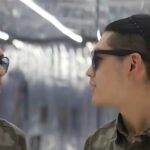Exhibition Dates: April 5 – 7, 2025
Venue: M P Birla Millennium Art Gallery
M P Birla Millennium Art Gallery, in collaboration with Y Manifesto and executive curator Yuran Lin, is pleased to present Partly Cloudy, a thought-provoking group exhibition that explores meteorological phenomena as potential metaphors for transitional states of being. Drawing from the ephemeral nature of weather patterns, the exhibition examines how fleeting moments of change can mirror personal and collective transformations. In this curatorial experiment, the condition of “partly cloudy”—often dismissed as mundane or vague—emerges as a compelling conceptual lens through which artists investigate themes of uncertainty, duality, and ontological flux.
Featuring a notable and diverse lineup of contemporary artists—including Anning Song, Bilan Liu, Jing Zhou, Jingsi Chen, Junxian Pan, Kewei Zhao, Lexiong Ying, Liying Peng, Lutong Li, Witty Wang, Xianghan Wang, Tremoring Steel (Xinyue Gao), Yongkang Yu, Zhihao Lin, and Yuchu Zhao, as well as an artist collective formed by Jiawen Zhu, Ziqing Chu, Ying Huang, and Yunyi Zhang—the exhibition brings together a multidisciplinary constellation of practices. Their works span a range of mediums, each offering unique perspectives on liminality and the beauty of unresolved states. Painting, photography, sculpture, video, installation, and new media converge in a dynamic visual dialogue, forming a kaleidoscope of expression that suggests the complexity of navigating in-between states.
At the heart of Partly Cloudy lies a considered embrace of liminality—a condition suspended between clarity and obscurity, stasis and transformation, the known and the unknowable. Rather than resisting ambiguity, the exhibition engages with it, drawing inspiration from contemporary theory, particularly the writings of philosopher Timothy Morton, whose exploration of rigid ontological boundaries encourages us to inhabit a more fluid, interconnected model of existence. This philosophical underpinning allows the artworks to resonate beyond the visual, prompting viewers to reflect on their own experiences of transition. Here, ambiguity is not a void, but a generative terrain—a fertile site of potential, inquiry, and imagination.
The exhibition avoids the urge to resolve or define. Instead, it invites viewers into a poetic atmosphere where light and shadow coexist, where contradictions are held without collapse. Through immersive installations and evocative imagery, the artists create spaces that embrace the unfinished and the uncertain. It poses open-ended questions: How do we dwell in spaces of unresolved becoming? How are identities shaped, fragmented, or dissolved in response to shifting cultural, emotional, and ecological climates? In what ways might art itself become a medium for exploring these thresholds?
Partly Cloudy approaches uncertainty not merely as a symptom of contemporary life, but as an integral feature of the human condition. It foregrounds the in-between, the half-seen, and the ambiguous—not to fix them, but to acknowledge their richness. By doing so, the exhibition opens a dialogue about the value of ambiguity in a world often demanding clear answers. The exhibition invites the viewer to participate in an ontological inquiry, one that questions binaries of self and other, presence and absence, clarity and confusion, real and imagined.
By shifting our attention toward what lies in transition—toward the gray zones, the hazy contours, the partly known—Partly Cloudy proposes a reconsidered way of perceiving, understanding, and inhabiting the world. The artists’ nuanced approaches remind us that meaning often resides in the process rather than the destination. It highlights the poetics of ambiguity and encourages us to see beauty and meaning in the very act of becoming.
Published by Jeremy S.

















